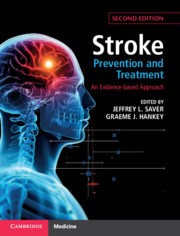Book contents
- Stroke Prevention and Treatment
- Stroke Prevention and Treatment
- Copyright page
- Dedication
- Contents
- Contributors
- Preface
- Part I Foundations
- Part II Systems of Care
- Part III Acute Treatment of Ischaemic Stroke and Transient Ischaemic Attack
- Chapter 5 Supportive Care during Acute Cerebral Ischaemia
- Chapter 6 Reperfusion of Ischaemic Brain by Intravenous Thrombolysis
- Chapter 7 Reperfusion of the Ischaemic Brain by Endovascular Thrombectomy and Thrombolysis
- Chapter 8 Collateral Flow Enhancement: Blood Pressure Lowering and Alteration of Blood Viscosity
- Chapter 9 Acute Antiplatelet Therapy for the Treatment of Ischaemic Stroke and Transient Ischaemic Attack
- Chapter 10 Acute Anticoagulant Therapy for the Treatment of Acute Ischaemic Stroke and Transient Ischaemic Attack
- Chapter 11 Treatment of Brain Oedema
- Chapter 12 Neuroprotection for Acute Brain Ischaemia
- Part IV Acute Treatment of Haemorrhagic Stroke
- Part V Prevention
- Part VI Stroke Rehabilitation and Recovery
- Index
- References
Chapter 7 - Reperfusion of the Ischaemic Brain by Endovascular Thrombectomy and Thrombolysis
from Part III - Acute Treatment of Ischaemic Stroke and Transient Ischaemic Attack
Published online by Cambridge University Press: 15 December 2020
- Stroke Prevention and Treatment
- Stroke Prevention and Treatment
- Copyright page
- Dedication
- Contents
- Contributors
- Preface
- Part I Foundations
- Part II Systems of Care
- Part III Acute Treatment of Ischaemic Stroke and Transient Ischaemic Attack
- Chapter 5 Supportive Care during Acute Cerebral Ischaemia
- Chapter 6 Reperfusion of Ischaemic Brain by Intravenous Thrombolysis
- Chapter 7 Reperfusion of the Ischaemic Brain by Endovascular Thrombectomy and Thrombolysis
- Chapter 8 Collateral Flow Enhancement: Blood Pressure Lowering and Alteration of Blood Viscosity
- Chapter 9 Acute Antiplatelet Therapy for the Treatment of Ischaemic Stroke and Transient Ischaemic Attack
- Chapter 10 Acute Anticoagulant Therapy for the Treatment of Acute Ischaemic Stroke and Transient Ischaemic Attack
- Chapter 11 Treatment of Brain Oedema
- Chapter 12 Neuroprotection for Acute Brain Ischaemia
- Part IV Acute Treatment of Haemorrhagic Stroke
- Part V Prevention
- Part VI Stroke Rehabilitation and Recovery
- Index
- References
Summary
Endovascular thrombectomy (EVT) with highly effective reperfusion devices is beneficial for: 1) relatively broadly selected acute ischaemic stroke patients with anterior circulation large vessel occlusions (LVOs) who have failed or are ineligible for intravenous fibrinolysis, up to 7 h after onset; and 2) imaging-selected patients with a favorable penumbral profile (small core and substantial salvageable tissue) 6–24h after onset. Among early-presenting patients, benefit is strongly time-dependent; for every 4 m delay in door-to-reperfusion time, 1 of every 100 patients has a worse disability outcome. Based on the trial evidence, EVT is strongly endorsed by guidelines worldwide. Within the first 7h, benefit is evident in patients under and over age 80, and in patients with up to moderate early ischaemic changes on imaging (ASPECTS 6-10). Systems of care should be optimized to deliver likely LVO patients to endovascular-capable stroke centers, and for procedure start (arterial puncture) within 75m, and optimally within 45m, after ED arrival. Large-scale trials are testing: best prehospital recognition and routing protocols: novel device designs to increase reperfusion rates in large and also medium vessel occlusions; bridging neuroprotection and collateral enhancement; potential benefit in patients with large cores; and best concomitant therapies, including sedation mode and post-procedure blood pressure management.
Keywords
- Type
- Chapter
- Information
- Stroke Prevention and TreatmentAn Evidence-based Approach, pp. 127 - 145Publisher: Cambridge University PressPrint publication year: 2020



